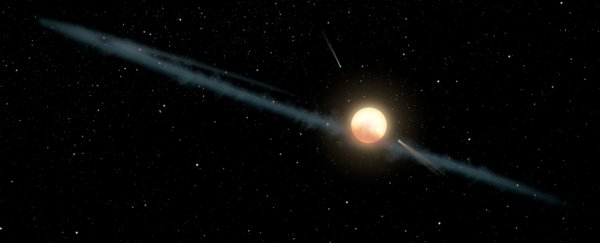Once again, a distant star know for its bizarre, unexplained light fluctuations has kicked into action, this time dipping in brightness more dramatically than ever.
KIC 8462852, also known as Tabby's Star or 'alien megastructure' star as we like to call it, has dimmed by at least 5 percent - maybe even as much as 10 percent, breaking the record for the deepest dip since the data collected by Kepler in 2011.
The dimming started on March 16, dropping down 4 percent, before returning to normal, according to an observation blog run by Tabetha Boyajian, the Louisiana State University astrophysicist who discovered the star.
Then the dimming started again on March 26.
"Today we have some very big news - data taken at TFN last night show the flux is down 5 percent," Boyajian wrote. "This drop has now been confirmed by AAVSO observer John Hall. Looks like we beat the record set just last week on the deepest dip observed since Kepler!"
holy flying spaghetti monster - we now have a 5% dip - this beats last weeks record of deepest dip detected since Kepler!!! - https://t.co/Y9Non8bv1P
— Dr Tabetha Boyajian (@tsboyajian) March 26, 2018
We don't know what this means yet, but the data will help build a better profile of the 1,280-light-year distant star to help figure out why it dims the way it does.
Kepler's main purpose is looking for dimming stars, since this is how we find exoplanets. When a planet passes between a star and Earth as it orbits, it will dim the star by a tiny amount - 1 percent or less - at regular intervals.
But Tabby's Star doesn't follow this pattern. Its dimming is highly irregular, occurring at unpredictable intervals, and to varying degrees.
In the 2011 Kepler observations, it dimmed as much as 22 percent. It had several major dimming events throughout 2017 - in May, June, August, September, October and November/December.
In addition, archives of data recently revealed that, in addition to dimming, the star has also gone through periods of significant brightening in the past.
Part of what's so perplexing about KIC 8462852 is that no one hypothesis seems to account for all the strangeness.
The "alien megastructure" idea that went viral was thrown out earlier this year after analysis determined that some wavelengths of light were blocked more than others - which wouldn't be the case if a structure was doing the blocking.
Other theories include a ringed planet passing in front of the star, either absolutely enormous or a smaller one with an orbital wobble; a swarm of comets; space junk; the star swallowing a planet; something happening inside the star itself; and the scientific equivalent of a shrug emoji.
But the most likely, and currently leading, explanation is an uneven cloud of dust swirling around the star, since that would block ultraviolet light more than infrared light.
It would have to be a metric butt-ton of dust to be able block 22 percent of the star's light, but that's not impossible, depending on the origins of such dust.
There have been two other stars observed with similar peculiar light fluctuations. White dwarf WD 1145+017 has dips of up to 30 percent in its stellar flux, which possibly indicates a dust disc.
And variable star RZ Piscium has been observed dimming erratically by up to 10 percent. It emits large amounts of infrared radiation, also pointing to dust as the culprit.
Observations of KIC 8462952 continue, and you can follow Boyajian's blog or the hashtag #TabbysStar for updates.
